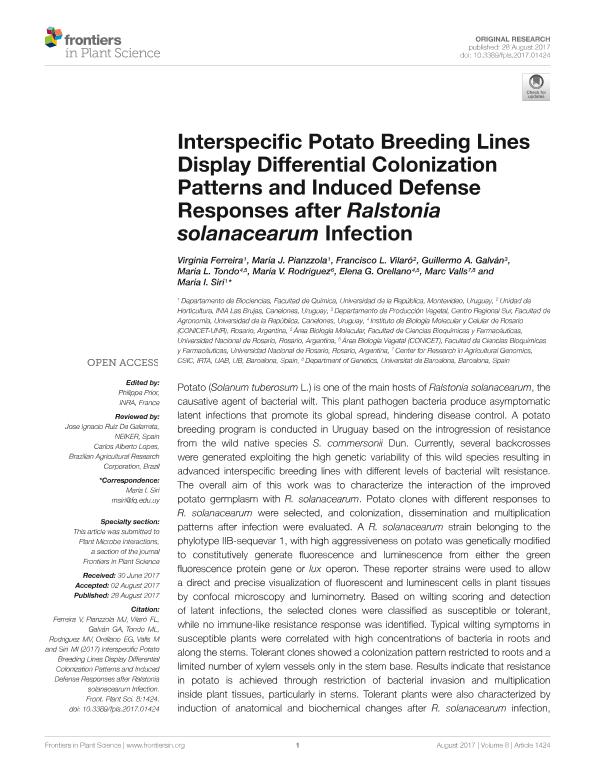Mostrar el registro sencillo del ítem
dc.contributor.author
Ferreira, Virginia
dc.contributor.author
Pianzzola, María J.
dc.contributor.author
Vilaró, Francisco L.
dc.contributor.author
Galván, Guillermo A.
dc.contributor.author
Tondo, Maria Laura

dc.contributor.author
Rodriguez, María Victoria

dc.contributor.author
Orellano, Elena Graciela

dc.contributor.author
Valls, Marc
dc.contributor.author
Siri, María I.
dc.date.available
2018-06-28T18:27:30Z
dc.date.issued
2017-08
dc.identifier.citation
Ferreira, Virginia; Pianzzola, María J.; Vilaró, Francisco L.; Galván, Guillermo A.; Tondo, Maria Laura; et al.; Interspecific potato breeding lines display differential colonization patterns and induced defense responses after Ralstonia solanacearum infection; Frontiers Research Foundation; Frontiers in Plant Science; 8; 8-2017; 1-14
dc.identifier.issn
1664-462X
dc.identifier.uri
http://hdl.handle.net/11336/50445
dc.description.abstract
Potato (Solanum tuberosum L.) is one of the main hosts of Ralstonia solanacearum, the causative agent of bacterial wilt. This plant pathogen bacteria produce asymptomatic latent infections that promote its global spread, hindering disease control. A potato breeding program is conducted in Uruguay based on the introgression of resistance from the wild native species S. commersonii Dun. Currently, several backcrosses were generated exploiting the high genetic variability of this wild species resulting in advanced interspecific breeding lines with different levels of bacterial wilt resistance. The overall aim of this work was to characterize the interaction of the improved potato germplasm with R. solanacearum. Potato clones with different responses to R. solanacearum were selected, and colonization, dissemination and multiplication patterns after infection were evaluated. A R. solanacearum strain belonging to the phylotype IIB-sequevar 1, with high aggressiveness on potato was genetically modified to constitutively generate fluorescence and luminescence from either the green fluorescence protein gene or lux operon. These reporter strains were used to allow a direct and precise visualization of fluorescent and luminescent cells in plant tissues by confocal microscopy and luminometry. Based on wilting scoring and detection of latent infections, the selected clones were classified as susceptible or tolerant, while no immune-like resistance response was identified. Typical wilting symptoms in susceptible plants were correlated with high concentrations of bacteria in roots and along the stems. Tolerant clones showed a colonization pattern restricted to roots and a limited number of xylem vessels only in the stem base. Results indicate that resistance in potato is achieved through restriction of bacterial invasion and multiplication inside plant tissues, particularly in stems. Tolerant plants were also characterized by induction of anatomical and biochemical changes after R. solanacearum infection, including hyperplasic activity of conductor tissue, tylose production, callose and lignin deposition, and accumulation of reactive oxygen species. This study highlights the potential of the identified tolerant interspecific potato clones as valuable genetic resources for potato-breeding programs and leads to a better understanding of resistance against R. solanacearum in potato.
dc.format
application/pdf
dc.language.iso
eng
dc.publisher
Frontiers Research Foundation

dc.rights
info:eu-repo/semantics/openAccess
dc.rights.uri
https://creativecommons.org/licenses/by-nc-sa/2.5/ar/
dc.subject
Bacterial Wilt
dc.subject
Disease Resistance
dc.subject
Latent Infections
dc.subject
Plant Breeding
dc.subject
Potato
dc.subject
Ralstonia Solanacearum
dc.subject
Solanum Commersonii
dc.subject.classification
Otras Ciencias Biológicas

dc.subject.classification
Ciencias Biológicas

dc.subject.classification
CIENCIAS NATURALES Y EXACTAS

dc.title
Interspecific potato breeding lines display differential colonization patterns and induced defense responses after Ralstonia solanacearum infection
dc.type
info:eu-repo/semantics/article
dc.type
info:ar-repo/semantics/artículo
dc.type
info:eu-repo/semantics/publishedVersion
dc.date.updated
2018-06-28T14:08:10Z
dc.journal.volume
8
dc.journal.pagination
1-14
dc.journal.pais
Suiza

dc.journal.ciudad
Lausana
dc.description.fil
Fil: Ferreira, Virginia. Universidad de la República; Uruguay
dc.description.fil
Fil: Pianzzola, María J.. Universidad de la República; Uruguay
dc.description.fil
Fil: Vilaró, Francisco L.. Instituto Nacional de Investigación Agropecuaria; Uruguay
dc.description.fil
Fil: Galván, Guillermo A.. Universidad de la República; Uruguay
dc.description.fil
Fil: Tondo, Maria Laura. Consejo Nacional de Investigaciones Científicas y Técnicas. Centro Científico Tecnológico Conicet - Rosario. Instituto de Biología Molecular y Celular de Rosario. Universidad Nacional de Rosario. Facultad de Ciencias Bioquímicas y Farmacéuticas. Instituto de Biología Molecular y Celular de Rosario; Argentina
dc.description.fil
Fil: Rodriguez, María Victoria. Universidad Nacional de Rosario. Facultad de Ciencias Bioquímicas y Farmacéuticas; Argentina. Consejo Nacional de Investigaciones Científicas y Técnicas; Argentina
dc.description.fil
Fil: Orellano, Elena Graciela. Consejo Nacional de Investigaciones Científicas y Técnicas. Centro Científico Tecnológico Conicet - Rosario. Instituto de Biología Molecular y Celular de Rosario. Universidad Nacional de Rosario. Facultad de Ciencias Bioquímicas y Farmacéuticas. Instituto de Biología Molecular y Celular de Rosario; Argentina
dc.description.fil
Fil: Valls, Marc. Universidad de Barcelona; España
dc.description.fil
Fil: Siri, María I.. Universidad de la República; Uruguay
dc.journal.title
Frontiers in Plant Science
dc.relation.alternativeid
info:eu-repo/semantics/altIdentifier/doi/http://dx.doi.org/10.3389/fpls.2017.01424
dc.relation.alternativeid
info:eu-repo/semantics/altIdentifier/url/https://www.frontiersin.org/articles/10.3389/fpls.2017.01424/full
Archivos asociados
